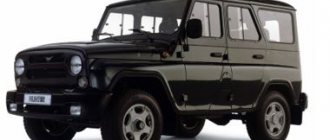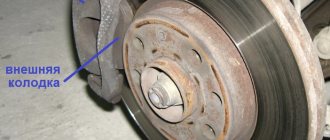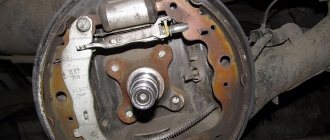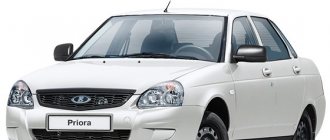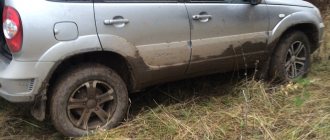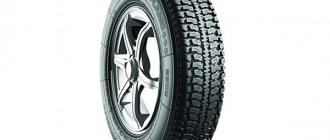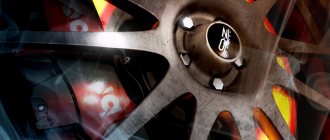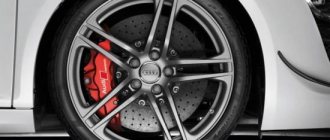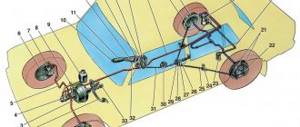VAZ 2110 replacement of brake discs
Let's start with the fact that the minimum permissible thickness of a brake disc for a ventilated one is 17.8 mm, and for a non-ventilated one - 10.8 mm.
If your parameters do not fit into these dimensions, then, for example, on a VAZ 2110, replacing the brake discs is simply necessary. By the way, in addition to the usual wear of the working surface, it is necessary to pay attention to the axial runout, which should not exceed 0.15 mm.
This problem usually occurs when, as a result of intense braking, the metal overheats and the disc “leads,” which can be expressed in a response beating in the brake pedal when braking.
In addition to the inevitable physical wear and tear, brake discs on the VAZ 2110 must be replaced if there are deep scuffs, scratches, and so on on the working braking surface. All these defects increase wear on the brake pads and reduce the effectiveness of the entire braking system of the car.
You can try to restore such a disc at specialized service stations, but you must remember that no one has canceled the minimum permissible thickness of discs.
In any case, you will have to replace the brake discs, including on the VAZ 2110, and you can perform this operation yourself, without resorting to the services of a service station.
First, you need to place the car on a flat surface, put it in gear and the handbrake, and also place wheel chocks under the rear wheels.
After jacking up the wheel, remove it and the brake pads.
After unscrewing the two bolts that secure the brake caliper with the swing arm, remove the latter without disconnecting it from the brake hose.
Important! To avoid damaging the brake hose, secure the caliper using a piece of wire to the coil of the front suspension spring.
Clean as much dirt as possible from the brake disc and unscrew the mounting bolts on the steering knuckle. You may have to pre-treat the areas of future dismantling with a liquid like VD-40, which corrodes rust well and makes it easier to deal with “rooted” detachable connections.
By unscrewing the two guide pins, you finally remove the problematic brake disc. You may also need a rubber hammer for this procedure.
Installing a new or restored disk is done in the reverse order.
Signs you need to replace drives
Not all car owners pay attention to the condition of their brake discs, which is why the problem of their failure occurs at the most inopportune moment. We recommend learning from the mistakes of others rather than making your own.
To determine whether the condition of the brake discs is close to the need to replace, it is recommended to do the following:
- Check the thickness of the brake disc. The normal size is 17 millimeters. This is when we are talking about ventilated discs;
- Non-ventilated elements have their own indicator, and it is 10 millimeters;
- Check runout. This parameter is normally 0.15 millimeters and does not exceed it;
- Runout indicators should be measured at professional service stations that are equipped with appropriate equipment. Independent measurements do not always give accurate results;
- Examine the surface of the brake disc. If you find any damage, defects, chips, or cracks, be sure to replace parts immediately;
- As for choosing new items, purchase them exclusively from certified stores that have permission to provide the appropriate services. Buying on the market can lead to fakes that do not meet strict safety standards. Alas, there are now more than enough such discs;
- You should buy ventilated discs, the shelf life of which is significantly longer than their non-ventilated counterparts, plus their efficiency is better. The air flow that cools the brakes approximately doubles the lifespan of a simple non-ventilated brake system.
Brake discs for VAZ 2110
VAZ 2110 is one of the most popular Russian models. The cost of consumables for Russian cars is usually cheap, and you can always save a lot. But there are components on which it is not worth saving; it will cost you more. These components include the brake system.
The basis of the braking system is the brake disc. Disc brakes on the VAZ 2110 are installed only on the front axle, which is where the main force during braking occurs.
Wheels on the VAZ 2110 are divided, depending on the engine, as follows:
- 8 valve VAZ 2110 engines are equipped with R13 brake discs
- 16 valve VAZ 2110 engines are equipped with R14 brake discs
Due to the low cost, many people do not hesitate to install original disks:
- 2108-3501070 — front brake disc r13, not ventilated, cost from 898 rubles.
Today, perhaps, the most unfortunate and unacceptable option. Due to the lack of ventilation, the disc is susceptible to overheating , which means the brake fluid will overheat and boil; this can be clearly felt when the pedal begins to go down. When brake fluid boils, the effectiveness of the brakes drops sharply and you risk being left without brakes at all.
- 2110-3501070 — front ventilated brake disc r13, cost from 3,758 rubles.
An improved version of the previous disc. The main improvement is the appearance of ventilation. The discs do not heat up so much and behave well during quiet driving.
- 2112-3501070 — front ventilated brake disc r14, cost from 919 rubles.
Perhaps the best option among the original discs. Here you have ventilation and an increased contact area with the block. Consequently, you have a lower chance of disc overheating and improved braking properties compared to previous options. Despite their advantages, such discs are not suitable for a driving style with constant brake loads, but remain reliable and comfortable brakes for quiet, everyday driving.
But the choice is not limited to originals. The VAZ 2110 is a popular model and a large number of analogue brake discs are produced for it. So, if you want to save money, you can take BM BD 5222.
- BM BD5222 front brake disc r13, not ventilated, cost from 512 rubles.
- BM BDV221 front ventilated brake disc r13, price from 622 rubles.
- BM BDV220 front ventilated brake disc r14, price from 842 rubles.
BM discs are made in China, and you can't count on improved braking quality. The main advantage of these discs is the price, which in percentage terms is significantly lower than the original discs. But due to the low cost of original disks, the real savings are negligible and it is better to overpay slightly and install original disks.
Thus, there is no point in chasing cheapness, but you can choose an analogue to improve the quality of braking, but here you will have to overpay in comparison with the original ones.
- TRW DF1748 front brake disc r13, not ventilated, cost from 893 rubles.
- TRW DF4108 front ventilated brake disc r13, cost from 920 rubles.
- TRW DF4107 front ventilated brake disc r14, price from 1013 rubles.
TRW is a good option. The brakes under normal conditions are comparable to the originals, but in extreme conditions they behave much better. The discs withstand overheating better , cool faster and provide better braking.
- Brembo 08.5211.10 front brake disc R13, not ventilated, cost from 784 rubles.
- Brembo 09.8894.14 front ventilated brake disc r13, cost from 1100 rubles.
- Brembo 09.8903.14 front ventilated brake disc r14, price from 1063 rubles.
Many people choose Brembo for their sporting history. Brembo discs are a truly high-quality product, although it is far from their sports developments. But the VAZ is not a sports car, so Brembo wheels fully meet the requirements of the car . Brembos withstand overheating well and provide excellent braking in all conditions.
- Ate 24.0112-0125.1 front brake disc r13, not ventilated, cost from 990 rubles.
- Ate 24.0120-0186.1 front ventilated brake disc r13, cost from 1590 rubles.
- Ate 24.0120-0187.1 front ventilated brake disc r14, price from 1596 rubles.
Disk options
To determine what the marking means, you need to know the width and diameter of the wheel product.
Drilling or bolting
This is one of the most difficult parameters to study, indicating the diameter of the mounting bolts. Drilling is measured from the center area of the stud to the opposite area where the element is located on the wheel.
Quite often, manufacturers indicate the disc bolt pattern parameters using shot depending on the number of holes for fastening.
Let's assume the figures are 6/222.25. The first number shows the number of drillings for fastening the bolts, and the second number indicates the drilling in millimeters.
Disc offset
This indicator is marked with the English letters ET. What is ET in disks and why is it needed? The indicator indicates the distance from the plane of the wheel product to the middle zone of the rim. The mating surface of the wheel product indicates the pressing plane of the disk to the hub.
Departure parameters can be:
- with zero indicator;
- with negative;
- with positive.
Zero offset indicates that the plane of the disc corresponds to its middle zone. Thus, the lower the indicator, the more the wheel product protrudes from the outside of the car. If the overhang indicator is increased, this means that the disc is deeper into the interior of the car.
It is also necessary to take into account the fact that depending on the width of the product, the overhang indicators differ. Manufacturers indicate in the documentation accompanying the vehicle a smaller offset value for wheels with a large width.
Diameter and other parameters of the disk schematically
What is HUMP(H)?
The hump is the protrusion of a ring on a disc rim. This element is used as protection against car tires coming off. Usually 2 humps (H2) are used for a wheel.
In some cases, a hump may not be used or only one may be used, depending on the vehicle configuration. Types of Humps:
- combined (CH);
- flat (FH);
- asymmetrical (AH).
PCD Disc Parameters
The PCD value refers to the diameter of the circle of the center holes on the wheel rim. That is, this is the diameter of the holes for fastening the bolts.
DIA drive option
The DIA parameter indicates the diameter of the hole located in the center of the disk. Casting manufacturers prefer to create a large DIA center hole diameter. This is done to ensure that the wheels are applicable and universal for all types of cars.
Despite the fact that the size of the hub may differ depending on the vehicle model, the auto disk is installed using an adapter ring or bushing.
Brake discs for VAZ 2110
Today the market offers a wide selection of different brake discs , not only for foreign cars, but also for Russian cars. What is the difference between regular brake discs and drilled brake discs ? Is it worth installing such wheels on a VAZ 2110?
Brake disc overview
For reference:
- 8 valve VAZ 2110 are equipped with R13 brake discs
- 16 valve VAZ 2110 are equipped with R14 brake discs
R14 brake discs cannot be installed on 13th radius car wheels.
Minimum permissible thickness of brake discs:
- For ventilated 17.8 mm
- For non-ventilated 10.8 mm
Brake discs are distinguished:
- Ventilated discs
- With gas outlets
- With perforation or grooves (slots)
- Collapsible
Let's look at each point in more detail.
The first option is ventilated discs . They are two separate disks, fastened together in such a way that they resemble blades (like a turbine). Thanks to these blades and channels, heat is dissipated more efficiently and the weight of the disc is reduced.
Example of simple ventilated brake discs .
During active braking, if the brake discs are not cooled enough, their temperature can reach 180-250 degrees. Regular pads start to smoke. The gas released when the pads rub against the heated disc serves as a layer between the disc and the pad and prevents the pads from fitting tightly to the brake disc. This is the main problem why braking disappears . To prevent such cases, there are gas outlets, perforations and grooves. An example of brake discs with gas outlets .
Another reason for brake failure can be carbon deposits on the pads, which appears during frequent braking (on a race track). This carbon deposit turns the block into a slippery ski. Gas outlets and perforations cut off this slippery layer, renewing the pad. But they make brake pads wear out faster . Example of brake discs with perforations and grooves .
In addition, perforations together with grooves help remove water, dirt, and dust, which reduces the risk of scratching the brake disc. They also increase additional braking force and reduce disc wear . An example of brake discs with gas outlets and perforations .
The fourth option is collapsible disks . As we already know, when braking, the brake discs heat up and the heat is transferred to the hub, and at high temperatures this unit is likely to fail. This is why some companies offer collapsible brake discs . They are a working disk, which is bolted to the middle part, which is attached to the hub. An example of dismountable brake discs .
Because The majority of car owners operate their cars on city roads, and not on ring tracks and races, then the effectiveness of standard brakes will be sufficient . If you still want to improve the car's braking system , then you should not install rear disc brakes, but rather change the brake discs to a larger diameter and install perforated brake discs . You will feel the difference immediately, not only in braking, but also in the appearance of your car (for example, by illuminating perforated wheels with LEDs).
